Discover 11 hidden attractions, cool sights, and unusual things to do in Lexington (United States). Don't miss out on these must-see attractions: University Chapel, Natural Bridge, and Stonewall Jackson House. Also, be sure to include Oak Grove Cemetery in your itinerary.
Below, you can find the list of the most amazing places you should visit in Lexington (Virginia).
Table of Contents
University Chapel
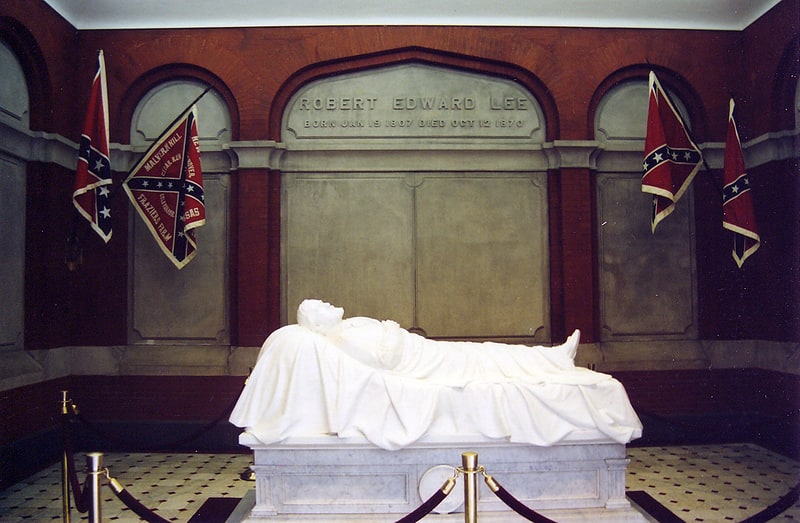
Chapel in Lexington city, Virginia. University Chapel of Washington and Lee University is a National Historic Landmark in Lexington, Virginia. It was constructed during 1867–68 at the request of Robert E. Lee, who was president of the school, and after whom the university is, in part, named. The Victorian brick architectural design was probably the work of his son, George Washington Custis Lee, with details contributed by Col. Thomas Williamson, an architect and professor of engineering at the neighboring Virginia Military Institute. Upon completion and during Robert E. Lee's lifetime it was known as the College Chapel. Lee was buried beneath the chapel in 1870.
The centerpiece of the apse of the chapel—in the place where an altar is located in the traditional plan of a Christian church—is a statue of Lee, in his uniform, asleep on an unnamed Civil War battlefield (the "Recumbent Lee"), by sculptor Edward Valentine, whose statue of Lee formerly displayed as one of Virginia's representatives in National Statuary Hall was removed from the U.S. Capitol, and whose statues of Jefferson Davis were removed from Richmond, Virginia's Monument Avenue and New Orleans.
The recumbent statue was unveiled and dedicated as the main feature of the chapel on June 28, 1883. The keynote speaker, John W. Daniel, soon to be a U.S. senator from Virginia, and filling in for the absent Jefferson Davis, said of Robert E. Lee's decision to lead the armed forces of Virginia at the outset of the Civil War, "Since the Son of Man stood upon the Mount, and saw 'all the kingdoms of the earth and the glory thereof' stretched before him, and turned away from them to the agony and bloody sweat of Gethsemane, and to the Cross of Calvary beyond, no follower of the meek and lowly Saviour can have undergone more trying ordeal. Thus, with as chaste a heart as ever plighted its faith until death, for better or for worse, came to do, to suffer, and to die for us." Reflecting upon Lee's death and its aftermath, Daniel continued, " has left a great, imperishable legacy to us and our heirs forever. The heart of man is his perpetual kingdom. There he reigns transcendent, and we exclaim: 'Oh, king, live forever.'" Daniel lamented that Lee had died a prisoner on parole, his American citizenship never fully restored: "The country which gave the right of suffrage to the alien ere he could speak its language, and to the African freedman ere he could read or understand its laws, denied to him the privilege of a ballot.. himself and his Commander-in-Chief constituting the most conspicuous of its political slaves." Washington and Lee History Professor Ted DeLaney, who was born and grew up in Lexington during Jim Crow and was the first Black chair of W&L's history department, in 2019 offered his opinion of the Robert E. Lee statue and its placement in the chapel: "The symbolism there is a violation of the first commandment."
On the chapel walls, on either side of the statue chamber alcove, are two paintings: one of President George Washington by Gilbert Stuart from 1796, and another of Lee painted by J. Reid, from 1866. In 2018, these replaced a portrait of Washington by Charles Willson Peale from the Washington family collections, and another of Lee in his uniform, painted by Edward Pine, in order to reflect the time periods of the association of each university namesake with the school. There is also a plaque given by the Sigma Society on one of the walls that honors two Sigma alumni from the classes of 1912 and 1915 who lost their lives in World War I.
In the basement a crypt (added after Lee's burial) contains the remains of much of Lee's direct family: Lee himself, his wife Mary Anna Custis Lee, his seven children—George Washington Custis Lee, Mary Custis Lee, William Henry Fitzhugh Lee, Anne Carter Lee, Robert E. Lee Jr. Eleanor Agnes Lee, and Mildred Childe Lee, and his parents—Revolutionary War Major-General Henry "Light-Horse Harry" Lee, and Anne Hill Carter Lee. Lee's favorite horse, Traveller, is buried just outside the Chapel, where many visitors leave coins, apples, and other tributes. In the basement of the Chapel is a museum that illuminates the history of the families of George Washington and Robert E. Lee as well as that of the university itself. Lee's office has been meticulously preserved almost exactly as it was when he died.
The Chapel plays a role in the modern operation of Washington and Lee. It seats about 600 in its main area and in a small, three-sided balcony. First-year students have assembled there to hear the president of the University's student-run Executive Committee speak on the school's Honor System. Important school-wide lectures, concerts, and other notable activities are held there from time to time. For many years the school's annual convocation of Omicron Delta Kappa, or ODK, a national honor society founded at Washington and Lee on December 3, 1914, was held in the Chapel on or about Robert E. Lee's birthday, January 19, in conjunction with a board of trustees-mandated university holiday/Lee commemoration called "Founders Day," a version of the Robert E. Lee Day birthday holiday still officially celebrated in a few southern states. In 2014, Confederate flags surrounding the Lee statue in the Chapel were removed after student petitions. At that time, Robert E. Lee's great-grandson and 1949 W&L alumnus Robert E. Lee IV wrote in favor of this change, saying, "In my view, removing the flags from the statuary chamber is overdue." Since 2018, large doors placed before the chamber housing the statue of Lee are closed for most university events, obscuring the chamber and statue, keeping it "functionally separate from the chapel's assembly hall" at those times, with the stated intention that in doing so the chapel can be "welcoming to all members of our community."
University Chapel was officially renamed from Lee Chapel on June 4, 2021, by the university's board of trustees. The university also announced the discontinuation of its school holiday known as "Founders Day," held on Robert E. Lee's birthday, and significant upcoming redesign and renovations of the Chapel to be overseen by the board "to restore its unadorned design and physically separate the auditorium from the Lee family crypt and Lee memorial sculpture."
University Chapel, then known as Lee Chapel, was designated a National Historic Landmark in 1960. Novelist Ralph Ellison became the first African American to speak there in 1963. There is currently no schedule of public tours.[1]
Address: 11-17 Letcher Ave, 24450 Lexington
Natural Bridge

State park in Natural Bridge, Virginia. Natural Bridge is a geological formation in Rockbridge County, Virginia, comprising a 215-foot-high natural arch with a span of 90 feet. It is situated within a gorge carved from the surrounding mountainous limestone terrain by Cedar Creek, a small tributary of the James River. Consisting of horizontal limestone strata, Natural Bridge is the remains of the roof of a cave or tunnel through which the Cedar Creek once flowed.
Natural Bridge has been designated a Virginia Historic Landmark and a National Historic Landmark. Since 2016, the bridge and its surroundings have been managed by the Commonwealth of Virginia as Natural Bridge State Park.[2]
Address: Us 11 & 130, 24578 Natural Bridge
Stonewall Jackson House

Museum in Lexington city, Virginia. The Stonewall Jackson House, located at 8 East Washington Street in the Historic District of Lexington, Virginia, was the residence of Confederate general Thomas "Stonewall" Jackson from 1858 to 1861.[3]
Address: 8 E Washington St, 24450-2529 Lexington
Oak Grove Cemetery
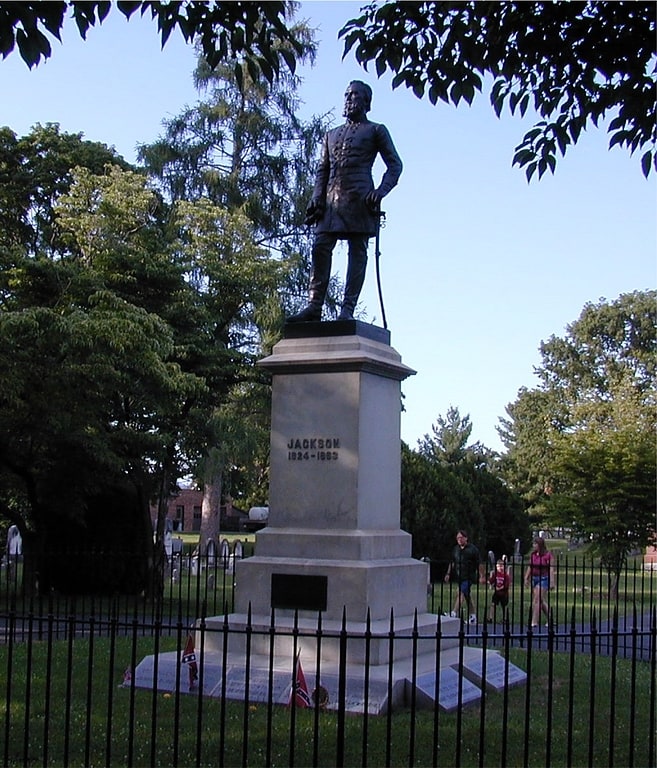
Cemetery in Lexington city, Virginia. The Oak Grove Cemetery, originally known as the Presbyterian Cemetery, is located on South Main Street in downtown Lexington, Virginia, less than a mile from the campuses of Washington and Lee University and the Virginia Military Institute. The cemetery was renamed in 1949 as the Stonewall Jackson Memorial Cemetery after the Confederate general, who was buried here in 1863. The current name dates to September 3, 2020. Also buried here are 144 Confederate veterans, two Governors of Virginia, and Margaret Junkin Preston, the "Poet Laureate of the Confederacy".[4]
Address: 314 S Main St, 24450-2320 Lexington
George C. Marshall Foundation

The George C. Marshall Foundation in Lexington, Virginia, was commissioned by President Harry S. Truman in order to preserve the papers of General George C. Marshall. Marshall served as Army chief of staff, secretary of state and defense and received the Nobel Peace Prize in 1953 for the Marshall Plan.[5]
Address: 1600 Vmi Parade, Lexington
Lexington Presbyterian Church
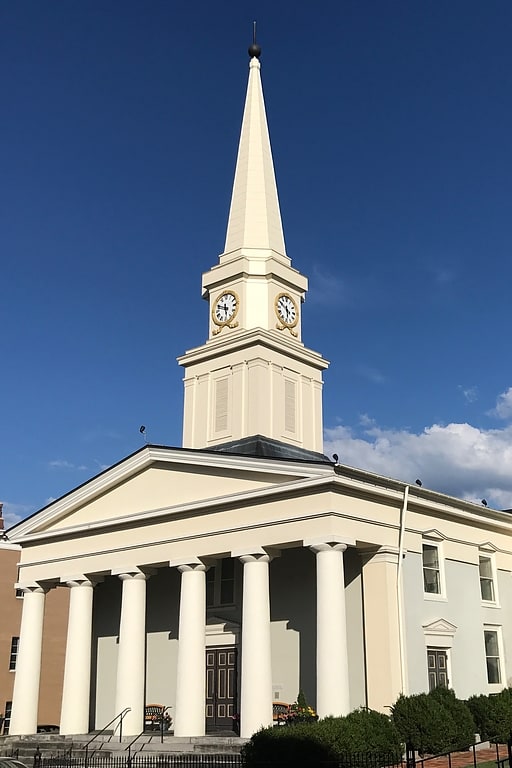
Church building in Lexington city, Virginia. Lexington Presbyterian Church is a historic Presbyterian church building at Main and Nelson Streets in Lexington, Virginia. It was designed by architect Thomas U. Walter in 1843, and completed in 1845. A rear addition was built in 1859; stucco added in the 1880s; the building was renovated and enlarged in 1899; and the Sunday School wing was added in 1906. It is a monumental "T"-shaped, temple form stuccoed brick building in the Greek Revival style. The front facade features a Greek Doric pedimented peristyle portico consisting of six wooden columns and a full entablature. The building is topped by a tower with louvered belfry and spire.
Starting in 1851, Stonewall Jackson was a member of the church and taught Sunday school. In 1863 he was buried in the church's cemetery which is now named for him.
It was listed on the National Register of Historic Places in 1979. It is in the Lexington Historic District.[6]
Address: 120 S Main St, 24450 Lexington
First Baptist Church
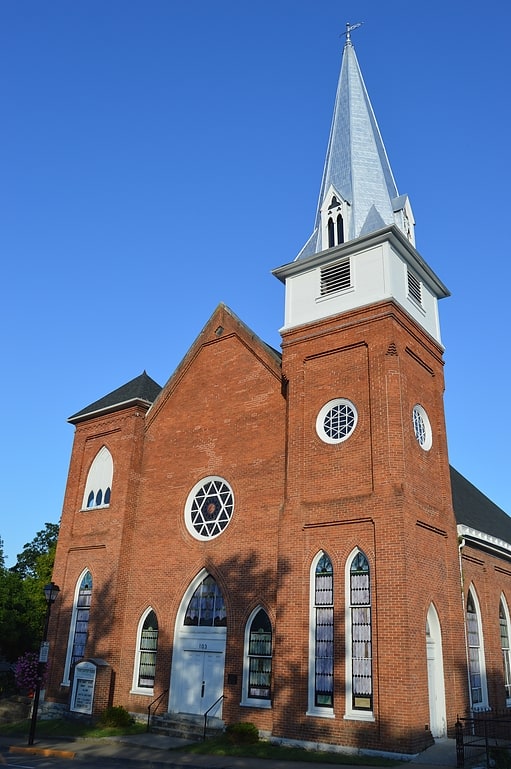
Church in Lexington city, Virginia. First Baptist Church, originally known as Lexington African Baptist Church, is a historic Baptist church building in the city of Lexington, Virginia, United States. It was built between 1894 and 1896, and is a large brick church on a limestone basement in the Gothic Revival style. It has a front gable roof, round and lancet-arch stained glass windows, and towers at its two front corners. The right hand tower has a belfry and spire. The interior consists of a barrel-vaulted auditorium with a gallery on turned posts and the basement has classroom and meeting spaces. Historically First Baptist played a central role in the life of Lexington's African-American community.
It was listed on the National Register of Historic Places in 2006.[7]
Address: 103 N Main St, 24450-2503 Lexington
Hull's Drive In
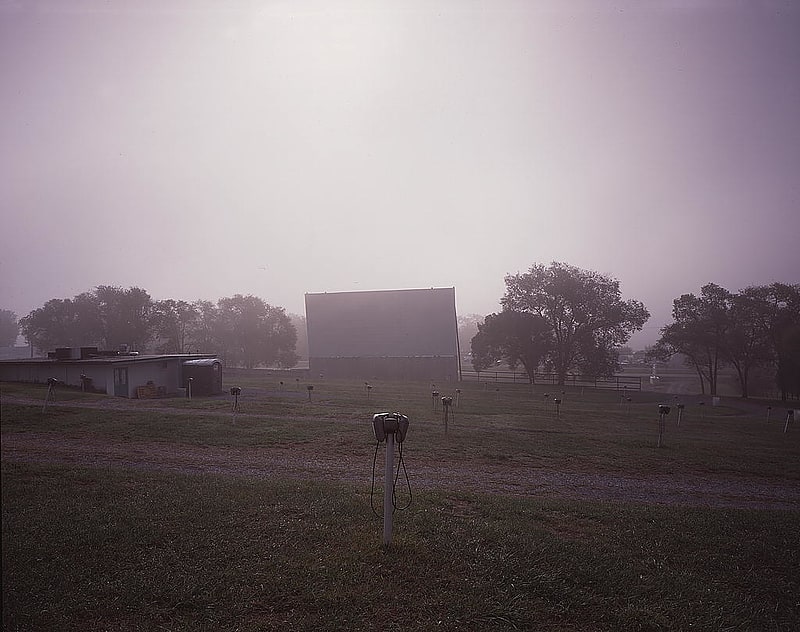
Theatre in Rockbridge County, Virginia. Hull's Drive In is a 319-space drive-in theatre in Lexington, Virginia, one of the seven drive-in theatres still currently operating in Virginia. It is one of only two non-profit drive-in theaters in the United States, the other being Warner's in nearby Franklin, West Virginia. It shows current, family-friendly movies every weekend between March and October.[8]
Address: Lexington, 2367 N. Lee Highway, Lexington, Virginia
Virginia Military Institute
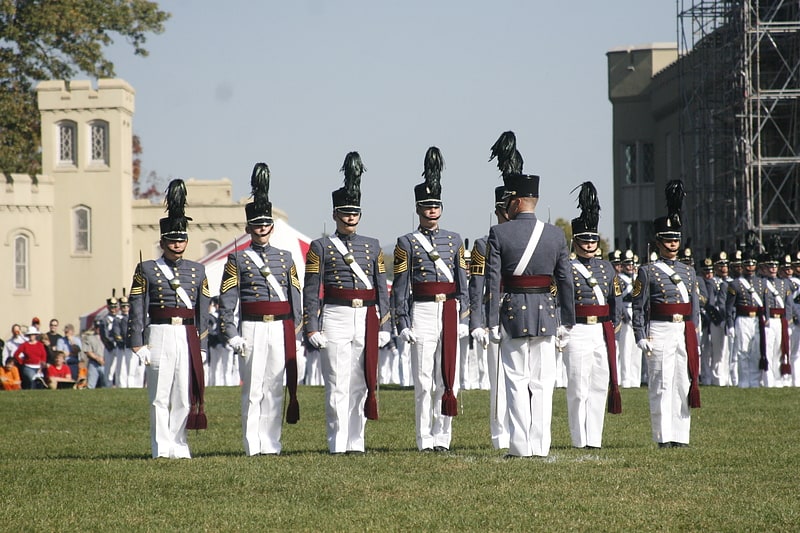
United states senior military college in Lexington city, Virginia. Virginia Military Institute is a public senior military college in Lexington, Virginia. It was founded in 1839 as America's first state military college and is the oldest public senior military college in the United States. In keeping with its founding principles and unlike any other senior military college in the United States, VMI enrolls cadets only and awards bachelor's degrees exclusively. VMI offers its cadets strict military discipline combined with a physically and academically demanding environment. The institute grants degrees in 14 disciplines in engineering, science, and the liberal arts, and all VMI students are required to participate in the Reserve Officers' Training Corps.
While Abraham Lincoln first called VMI "The West Point of the South" because of its role during the American Civil War, the nickname has remained because VMI has produced more Army generals than any ROTC program in the United States. Despite the nickname, VMI differs from the federal military service academies in many regards. For example, as of 2019, VMI had a total enrollment of 1,722 cadets (as compared to 4,500 at the Academies) making it one of the smallest NCAA Division I schools in the United States. Additionally, today (as in the 1800s) all VMI cadets sleep on cots and live closely together in a more spartan and austere barracks environment than at the Service Academies. All VMI cadets must participate in the Reserve Officers' Training Corps (ROTC) of the United States Armed Forces programs, but are afforded the flexibility of pursuing civilian endeavors or accepting an officer's commission in the active or reserve components of four of the U.S. military branches upon graduation.
VMI's alumni include a Secretary of State, Secretary of Defense, Secretary of the Army, a Nobel Peace Prize winner, 7 Medal of Honor recipients, 13 Rhodes Scholars, Pulitzer Prize winners, an Academy Award winner, an Emmy Award and Golden Globe winner, a martyr recognized by the Episcopal Church, Senators and Representatives, Governors, Lieutenant Governors, a Supreme Court Justice, numerous college and university presidents, many business leaders (presidents and CEOs) and over 290 general and flag officers across all US service branches and several other countries.[9]
Address: Letcher Ave., Lexington
Boxerwood Gardens
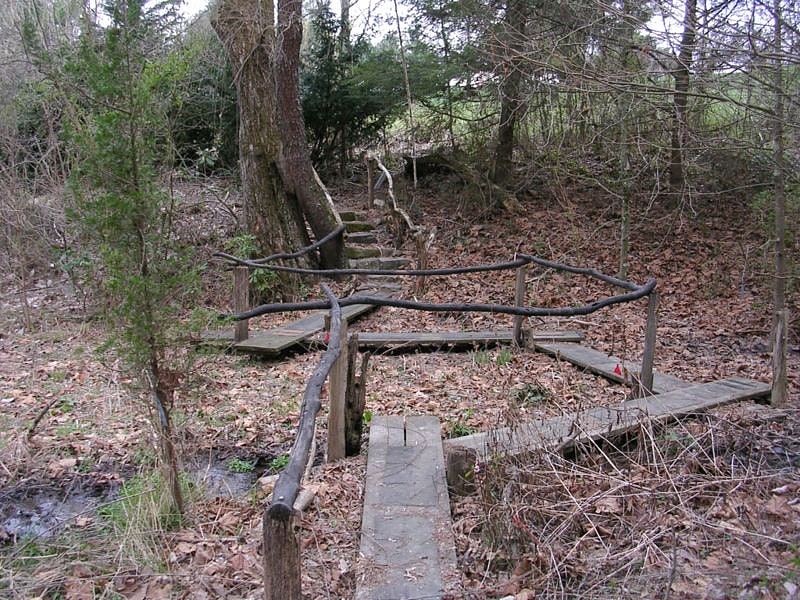
Non-profit organization in Rockbridge County, Virginia. Boxerwood Nature Center and Woodland Garden is a 15-acre arboretum featuring both native and unusual plant specimens, located within a larger preserve at 963 Ross Road near Lexington in Rockbridge County, Virginia, United States in the Shenandoah Valley. Established as a private garden in 1952, it was listed on the National Register of Historic Places in 2015.
The Arboretum contains thousands of labeled trees and shrubs, including 1,300 cultivars, with fine collections of dwarf conifers, magnolias, dogwoods, rhododendrons, azaleas and Japanese maples.
Examples of its collection include: 163 varieties of Acer palmatum (Japanese Maple), Abies nebrodensis (Sicilian Fir), Acer buergerianum (Trident maple), Acer griseum (Paperbark Maple), Acer pensylvanicum (Striped maple), Aesculus parviflora (Bottlebrush Buckeye), Aesculus pavia (Red Buckeye), Aesculus x carnea 'Briottii' (Red Horsechestnut), Chaemaecyparis obtusa (Hinoki Falsecypress), Chionanthus virginicus (White Fringetree), Cladrastis kentuckea (American Yellowwood), Cryptomeria japonica (Japanese Cedar), Halesia tetraptera (Carolina Silverbell), Ilex verticillata (Winterberry), Liquidunbar styraciflua 'Corky' (Corky Sweetgum), Malus 'Red Jade' (Red Jade Crabapple), Picea omorika 'Pendula' (Weeping Serbian Spruce), Syringa reticulata (Japanese Tree Lilac), Taxodium distichum (Baldcypress), Taxus species (Yews), Thuja occidntalis (American Arborvitae), and Viburnum prunifolium (Blackhaw viburnum).
Boxerwood Nature Center has a PlayTrail, a nature playground designed especially for young children. Kids can run through the plant tunnels, float leaves down the mini creek, make pies in the mud kitchen, climb tiny house mountain and more. The rules include "make noise," "touch anything," "get dirty," and "have fun". There is also a Fairy Forest where children can build their own fairy structures, and a wetland walk where visitors can cross the zigzag bridge over the garden wetlands. In fall 2016, a pollinator garden was added to the gardens.[10]
Address: 963 Ross Rd, 24450-6151 Lexington
Washington and Lee University
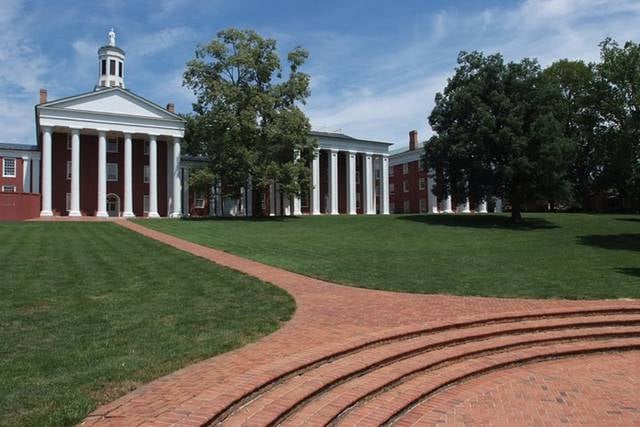
Historical place, Universities and schools
Address: Jefferson St., Lexington